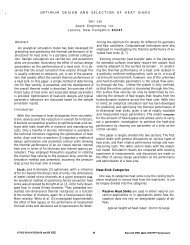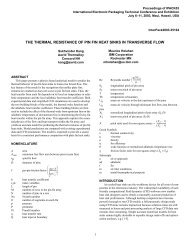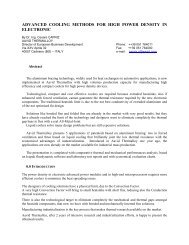THERMAL PERFORMANCE OF AN ELLIPTICAL PIN FIN HEAT SINK
THERMAL PERFORMANCE OF AN ELLIPTICAL PIN FIN HEAT SINK
THERMAL PERFORMANCE OF AN ELLIPTICAL PIN FIN HEAT SINK
Create successful ePaper yourself
Turn your PDF publications into a flip-book with our unique Google optimized e-Paper software.
<strong>THERMAL</strong> <strong>PERFORM<strong>AN</strong>CE</strong> <strong>OF</strong><strong>AN</strong> <strong>ELLIPTICAL</strong> <strong>PIN</strong> <strong>FIN</strong> <strong>HEAT</strong> <strong>SINK</strong>Christopher L. Chapman, and Seri LeeAavid Engineering, Inc.Laconia, New Hampshire 03247Bill L. SchmidtSilicon Graphics Computer SystemsMountainview, California 94039AbstractComparative thermal tests have been carried out usingaluminum heat sinks made with extruded fin, cross-cutrectangular pins, and elliptical shaped pins in low air flowenvironments. The elliptical pin heat sink was designed tominimize the pressure loss across the heat sink by reducingthe vortex effects and to enhance the thermal performanceby maintaining large exposed surface area available for heattransfer. The performance of the elliptical pin heat sinkwas compared with those of extruded straight and crosscutfin heat sinks, all designed for an ASIC chip. Theresults of the straight fin were also compared with thoseobtained by using Sauna TM , a commercially available heatsink modeling program developed based on empirical expressions.In addition to the thermal measurements, theeffect of air flow bypass characteristics in open duct configurationwas investigated. As expected, the straight finexperienced the lowest amount of flow bypass over the heatsink. For this particular application, where the heat sourceis localized at the center of the heat sink base plate, theLm;fNuPrQQconuQratiRRbaseRj%RetTa~bT anT.T.overall thermal resistance of the straight fin was lower thanthe other two designs mainly due to the combined effect of Greek Symbolsenhanced lateral conduction along the fins and the lowerflow bypass characteristics.APNomenclatureACA,A pAFadA.CpDhfHhh~jKklchannel cross sectional area, m 2fin surface area, m 2projected area of heat sink base plate, m 2effective radiative surface area, m2wetted surface area, m 2specific heat of air, kJ/kgKhydraulic diameter, mfanning friction factorfin height, meffective heat transfer coefficient, W/m 2 Kbulk flow heat transfer coefficient, W/m 2 KColburn factortotal dynamic resist ante coefficientthermal conductivity of fin material, W/mKcharacteristic length, mfin parameter defined in Eq. (6), m-lma9s flow rate, kg/8number of finsNusselt numberPrandtl numberrate of total heat transfer, Wrate of convective heat transfer, Wrate of radiative heat transfer, Woyerall thermal resistance, ‘c/wconductive resistance of base, 0 C’/ Wfin thermal resistance, “c/wconvective resistance of base, 0 C’/ WReynolds numberfin thickness, mambient temperature, Kinlet air temperature, Kbulk mean air temperature, Kwall temperature, Kbulk mean flow velocity, m/spressure drop, Pa6 thickness of base plate, mc radiative surface ernissivityL’f fin efficiencyP fiuid density, kg/m 3u Stefan-Boltzmann constant, 5.67 x 10 -8 W/m2K4IntroductionAs the amount of heat that needs to be removed frommicroelectronic devices constantly increases, thermal engineersare faced with never-ending challenges not only toprovide innovative thermal designs but also to push thelimits of the available technology and existing hardware.The heat sink industry, traditionally suppliers of coolingproducts, is always searching for new technologies whichenhance thermal performance with no cost penalties. Heatsink features that incorporate findings from thermal re-0-7803-18S2-8/W/$3 .00 01984 IEEE 24 Tenh IEEE SEMI-THERMP
search and manufacturing breakthroughs are sought after was examined, and the results are compared with those ofas new product offerings. With this in mind, an elliptical other type of heat sinks as a qualification study for generalshaped pin fin heat sink is of interest and needs to be inves- usage. For comparison, equal volume heat sinks were pretigatedto find applicability as a general cooling product. pared using cost effective, existing heat sink technologies.In Figure 1, they are represented as straight and cross-cutheat sinks. The elliptical pin heat sink is made of cast aluminum,and the cross-cut and straight fin heat sinks aremade of extruded aluminum. The present study is a generalizedcomparison in which the effects that the differencesin thermal conductivity, flow characteristics, and pressuredrop have on the heat sink performance are measured interms of the thermal resistance (from the heat sink surfaceto the ambient air) and the amount of flow bypass.The thermal network of a finned heat sink consists ofconductive, radiative, and convective resistances. From thejunction of the device, heat is transported by conductionfrom the device through the interface and into the heat sinkfrom which heat is usually removed by means of convectionand radiation cooling. Fin efficiency and convection effectivenesscan be examined to minimize any significant conductionresistance though the fins and improve the overallperformance of the heat sink. There exists significant workcarried out in the thermal analysis of heat sink design. Ananalytical approach was taken by Keyes [1] who developedformulas for the fin and channel dimensions that provideoptimum cooling under various forced convection coolingconditions. Bartilson [2] investigated, using both experimentaland numerical techniques, air jet impingement coolingon a rectangular pin-fin heat sink. Various shapes oflongitudinal straight fin heat sinks were experimentally examined,and the thermal performance measurements werecompared with existing correlations [3]. Kishimoto andSasaki [4] examined cooling characteristics of a staggered,diamond-shaped pin fin heat sink, and Lee et. al [5], andSparrow and Kadle [6] investigated the effect of air flowbypass through tip-to-shroud clearance.A study of heat sink fin technologies has given informationtoward important design criteria for practical cooli~of electronic components. An elliptical pin fin heatsink was developed with specific design parameters; maintaininglarge exposed surface area for heat transfer andminimizing vortex flow by incorporating an air foil design.The air foil design in the shape of an ellipse was chosento reduce boundary layer buildup and any vortex affect.The result in a microelectronic environment is minimizeddownstream air heating and less pressure drop especiallywhen multiple heat sinks are placed in series. The applicationincludes ASIC chips arranged behind each other inthe direction of the air flow. This specific multiple heatsink design feature is not investigated here. Rather, thethermal performance of a single elliptical pin fin heat sinkThermal ModelingThe design of elliptical pin heat sinks challenges existingthermal modeling techniques. It is generally accepted thatthe most comprehensive modeling for a heat sink systemwould be computational fluid dynamics (CFD). Either byusing a finite volume or finite difference method, the actualphenomena at the fin surface can be quantified. Unfortunately,significant modeling and run time is neededto accurately represent small pins with complex meshing.A second technology, finite element analysis (FEA) canalso be useful in determining performance, especially conductivitygradients. The heat transfer coefficient can bedetermined using advanced FEA codes which incorporatefluid mechanics. However, pin fin geometry cannot easilybe modeled by using either method. Each pin mustbe individually discretized, increasing the modeling timesubstantially. The approach taken in this paper was tocompare this elliptical shaped heat sink with a conventionalextruded fin heat sink of equal volume. Comparativetesting can be correlated with accepted rectangularfin modeling techniques. The use of empirical correlationsand analytical modeling has been traditionally focused atrectangular longitudinal fins. As a control, this straight finheat sink can be tested against a cross-cut equivalent andthe elliptical pin heat sink.A simulation program has been developed for predictingand optimizing thermal performance of hi-directionalIa) Elliptical Pin Fins b) Cross–Cut Pin Finsc) Straight FinsFigure 1: Schematic diagram of heat sinks.25Tenth IEEE SEMI-THE-
The model equation, used for radiation heat loss in parallelmode with convection heat transfer (see Figure 2), isthe Stefan-Boltzmann equation:where Tw and Tamb are the absolute surfacetemperatures, respectively.(13)and ambientA commercial package is available which incorporatesthe above expressions. Sauna‘M from Thermal Solutions,Inc. [10] is a conjugate thermal modeling tool which incorporatescomputer aided design and heat transfer. Themodeling and run times are only a fraction of those requiredwith CFD and FEA analyses. This softwar~ allowsfor accurate modeling of the heat sink base plate withfins by accounting for conduction heat transfer in the baseplate as well as convection and radiation heat transfer fromthe exposed surfaces. The thermal gradients are predictedalong the entire heat sink base plate. The local temperaturesare obtained at the locations where thermocouplesare placed in the test samples.MeasurementThe test samples included elliptical pin finned, extrudedstraight finned, and extruded cross-cut finned (rectangularpin fins) heat sinks. The elliptical pin heat sink was madeof cast aluminum alloy. Although, the thermal conductivityis two-thirds that of an extrusion alloy, the specificpin detail can only be made economically by this process.Each pin is in the shape of an ellipse with a major axis of5.54 mm and a minor axis of 1.27 mm. However, the leadingand trailing ends of the ellipse came to a sharp edge,simulating the airfoil feature. The 105 pins were staggeredwith an outer grid being 10 x 6 and an inner grid of 9 x 5.In order to determine the applicability of this shape in heatsink design, similar test samples with conventional rectangularlongitudinal extruded fins were made.Q COmvQrutFigure 2: Thermal test module.Double SidedThermal TapeHeater BlockInsulationThe heat sink extrusion chosen for this testing has ten1.52 mm thick fins equally spaced across 58.42 mm. Theoverall height of the profile was 29.21 mm with a basethickness of 2.54 mm. Two extruded heat sinks were madeand one had an additional manufacturing process calledcross-cutting. This material removal enables air to passthrough pins in a manner similar to the elliptical pin findesign, There were nine cuts along the 58.42 mm length,and each cut removed 1.52 mm of material with 4.32 mmlong pins. All three heat sinks have equal volume, and thetotal surface area was also calculated to be nearly identical.Since the cross-cutting operation removed materialin width which was the same size as the fin thickness, nodifference in surface area is seen between the straight andcross-cut heat sinks. Using the complete elliptic integral ofthe second kind to determine the perimeter of each ellipse,the total exposed surface area of the elliptical pin heat sinkwas calculated to be 339.2 cm 2 compared to 346.8 cm 2 forthe extruded heat sinks.Each heat sink had a finish with an estimated emissivityof 0.8 minimum. This was done by black sulfuric acidanodizing the extruded heat sinks, and using black paintfor the cast elliptical pin heat sink. Thus, radiative heattransfer was included in the testing and combined with theconvection component to represent parallel heat transferfrom the surface of the fins, as depicted in Figure 2.A central backside pedestal 25.4 mm square was machinedinto the extruded samples and cast into the ellipticalpin fin heat sink. This simulated an actual design featurein order to properly contact the semiconductor die. Thesurface was covered with a double sided thermal tape whichheld the heat sink to a heater block simulating the device.A pneumatic piston fixture was used to apply 1.93 MPa ofmounting pressure for five minutes at the interface. Theconductive thermal resistance from the copper block to theheat sink surface was designed to be constant and is notincluded in the thermal resistance values obtained. Theblock was insulated using Styrofoam, so that only the heatsink was exposed to the air flow. The shape of this copperblock was designed to replicate the ASIC chip for which theelliptical heat sink was designed for. Two Caddock KoolTab TO-220 resistors were soldered to the copper blockas heat sources. Each 20f2 resistor was measured to bewithin l% of the rating. A Lambda LQ-532 power supplywas used to provide up to 20 watts into each resistor, resultingin the total heat flux of 40 W/in2, or 6.2 W/cm 2 .The power was determined using a Micronata Multimeter22-186A to measure the voltage drop across each resistor.The temperature measurements were taken using OmegaT-36SLE copper constantin thermocouples 0.43 mm in diameter.Three temperatures were taken throughout theexperiment, the ambient air 150 mm upstream of the heatsink, the heat sink pedestal, and the copper block. Theheat sink and ambient temperature difference waa usedto represent heat sink performance. Both the heat sinkand block thermocouples were inserted into a 1.0 mm di-”27 Tenth IEEE SEMI-THERAP
60504020Air Velocity (m/s)4 open (0.5)~* Q.=(1.o) ,,--9- open (2.0) :;.+ open (4.0)“ +. conf(o.5) ‘~: -0- Conf(l.o) “ --- ” -- -“”’--”--”-----”---”~”” ------------ + conf(2.o) /’:+ conf(4.o) +;. . . . . . . . . . . . ...>..... . . . . . . . . . . . . ,. . . . . . . . . . . . . . . . . . . . . . . . . . . . . . . . . . . . . . . . . . . . . . . . . .[lb?p....... . . . ..f . . . . . . ..f . . . ..+ . . .. f....‘‘f. . . . . . . . . . . . . . . . . . . . . . . . . . . . . .[ p . . . . ..-..~ . . . . 1// .‘7. .. f.y . .. ....i“i!-AA’7R“3”-”---”””--”40353025kg n, 9 2 0#1510~ F. ..-.Air Velocity (m/s)+ open (0.5)4 Open(l.o)+ open (2.0)+ open (4.0)+ conf(o.5)k---, .I 1~Conf(l.o) ~‘-”-” -0- conf(2.o) “-j ‘-”---”--”---” , ‘-”-””-------”+ conf(4.o) ~;. . . . . . . . . . . . . . . . . . . . . . . . . . . . . . . . . . . . . . . . . . . . . . . . . . . . . . . . . . . . . . . . . . . . . . . .. . . . . . . . . . . . . . . . . . . . . . . . . . . . . . . . . . . . . . . . . . . . . . . . . . . . . . . . . . . . . . . . . . . . . . . . . . .. . . . . . . . . . . . . . . . . . . . . . . . ..:.. . . . . .d. . . . . . . . . . . . . . . . . . . . . . . . . . . . . . . . . . . .b------------F--#-,10/lzw. . . . . . . . . . . -Y}5-------------------------------- ---0rlfllll’11’l’11’l’l’1110 10 20 30 40 50Q(watt)01 I 1,, , ,1,,,,1,,,,0 10 20 30 40 50Q(watt)Figure 8: Forced convection performance of elliptical pinfin heat sink based upon entering air velocity into the testchamber for both open and confined flow configurations.Figure 9: Forced convection performance of straight finheat sink based upon entering air velocity into the testchamber for both open and confined flow configurations.i.flow where the velocity through each heat sink is the same.Once again, the straight fin performed best. This was anunexpected result, but can be explained by looking at theoverall heat sink efficiency. Much emphasis in heat sinkdesign is spent looking at fin efficiency. However, withincreasing heat flux in microelectronic applications, the efficiencyof how fins conduct laterally may have been overlooked.The straight fin allows for an improved lengthwiseconduction path other than just through the base. Bothpinned versions have an overall higher conduction resistance,since the pins directly over the 25.4 mm square heatsource are at a higher temperature than the surroundingouter pins, Further testing including infrared spectroscopycan quanti& this effect.The measured temperature rises, plotted in Figure 8 forthe open and confined flows over the elliptical pin heat sink,reveal the thermal effect of bypass air in the open configuration.Other elliptical pin configurations with a moreopen cross sectional area may result in less flow bypass. InFigure 9, the result of the straight fin heat sink shows lessof an effect of the open configuration as expected, sincethe exiting flow velocity is nearly identical to the entrancevelocity.The thermal modeling using Sauna‘M was performed onthe straight fin heat sink. Figure 10 is a comparison be-tween the experimental data and the modeling. For low air80 f 1 , 4(Air Velocity, mk) I70■ Exp (0.5)I+ Theory (1 .0)60+ Theory (2.0)50A Exp (4.0)40I1I30 1I,I I 1 I 1 1 i I I 1 I 1 I I 1,,,,,1,,,1,,,,,’ *,, Jo 10 20 30 40Q(watt)Figure 10: Comparison of theoretical predictions with experimentalmeasurements for the extruded straight fin heatsink.tI30 Tenth IEEE SEMI-THEFNPI
velocity, the predictions are in good agreement. However,poor agreement is observed for higher flow velocities, suggestingthat the turbulence effects in the wind tunnel maynot be accurately modeled in the analysis. This may resultfrom the low critical Reynolds value used in Sauna TM forturbulent flows.ConclusionsThe testing described in this paper incorporates severalpossible performance factors into two terms; flow bypassand overall thermal resistance. These simplified terms representa combination of several factors, such as materialconductivity, lateral fin conduction, boundary layer formation,effective surface area, and pressure drop. In comparingthe elliptical pin heat sink with the rectangular pinheat sink, the air foil benefits are visible. There was 40%more air flowing through the rectangular pin design, yetthe thermal resistances were virtually equal. The ellipticalpin enhances heat transfer. These results are in correlationwith the basis of the elliptical pin fin design considerations;i.e. reduced vortex flow, eliminating boundarylayer effects. Another surprising result was that the extrudedstraight design performed significantly better thaneither of the other two designs over the flow range examinedherein.The comparison between the extruded and rectangularpins at similar air bypass indicates a performance factornot considered previously. The effect of lateral fin conducticmis significant at either high air velocities (> 3 m/s) orat high heat flux. The heat flux of 6.2 W/cm 2 is rathersignificant for this size of heat sink and low air flows. Adesign principle of heat sinks which is often assumed is theability to cool in an omni-directional air flow environment.The cross-cut heat sink offers ease of production assemblywhere misalignment of the heat sink with respect to thedirection of air flow will not result in a failure.Further study is needed to quantifj two key design parameters.The effect of heat flux and air flow relating to lateralfin conduction. This study would allow the increasingpower devices currently being developed to use cost effectiveair cooled heat sinks. This lateral conductance maylead to reducing the need for additional spreader platesand possible heat pipes. If the fin is used as the transportmeans of heat, more effective and less costly designs willbe apparent.The elliptical pin heat sink test ed represents only oneset of design parameters relating pin spacing and shapebased upon minor and major axes. There may exist otherdesigns which produce better results in overall thermal performance.A study looking at reduced spacing, pin alignment,pin staggering, and an array of ellipse axis ratioswould be advantageous to the heat sink industry.AcknowledgmentsThe authors would like to thank Mr. Raul Rodriguez forhis assistance in experimental apparatus setup, Mr. JoshuaWest for running the test and recording data, and Mr. RonLavochkin for his valuable comments during the preparationof this manuscript. Thanks also go to Mr. RickGagnon for his assistance in preparing the figures.References1.2.3.4.5 06.7.8.9.10.11.R.W. Keyes, “Heat Transfer in Forced ConvectionThrough Fins,” IEEE Transactions on Electronic Devices,Vol. ED-31, No, 9, pp. 1218-1221, 1984.B. W. Bartilson, “Air Jet Impingement on a MiniaturePin-Fin Heat Sink,” ASME Paper No. 91-WA-EEP-41, 1991.H. Matsushita and T. Yanagida, “Heat TransferFrom LSI Packages With Longitudinal Fins In aFree Air Stream,” Advances in Electronic Packaging,ASME Proceedings, EEP-VO1. 4-2, pp. 793-800, 1993.T. Kishimoto and S. Sasaki, “Cooling Characteristicsof Diamond-Shaped Interrupted Cooling Fin ForHigh-Power LSI Devices,” Electronics Letters, Vol. 23,pp. 456-457, 1987.R.S. Lee, H.C. Huang and W.Y. Chen, “A ThermalCharacteristic Study of Extruded Type Heat Sinks InConsidering Air Flow Bypass Phenomenon,” Proceedingsof the 6th Annual IEEE Semiconductor Thermaland Temperature Measurement Symposium, pp. 95-102, 1990.E.M. Sparrow and D.S, Kadle, “Effect of Tip-to-Shroud Clearance on Turbulent Heat ‘llansfer Froma Shrouded, Longitudinal Fin Array,” ASME Journalof Heat Tkansfer, Vol. 108, pp. 519-524, 1986.W.M. Kays and A.L. London, Compact Heat Exchangers,3rd Ed., McGraw-Hill Company, New York, 1984.I.E. Idelchik, Handbook of HydrauZic Resistance, 2ndEd., Hemisphere Publishing, New York, 1986.G. Ellison, Thermal Computations For ElectronicEquipment, Van Nostrand Reinhold Co., New York,1984.M. Naughton, Sauna ‘M User Manual, Version 2.10-2,Thermal Solutions, Inc., 1992.F.P. Incropera and D.P. DeWitt, Fundamentals ofHeat and Mass llansfer, 3rd Ed., John Wiley & Sons,New York, N.Y,, 1990.31Tenth IEEE SEM1-THERh@














